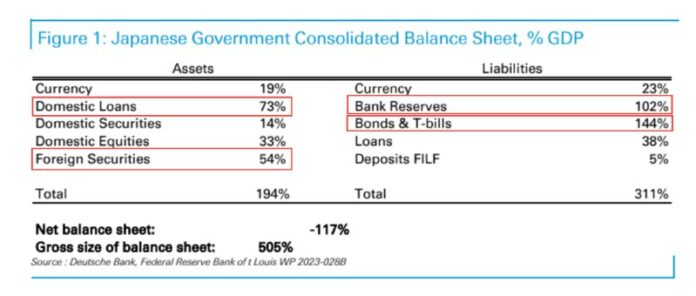The World’s Biggest Carry Trade
The Bank of Japan (BOJ) is facing a dilemma – they cannot afford to hike interest rates due to the massive $20 trillion carry trade that the government of Japan is engaged in. The carry trade involves borrowing in one currency cheaply (Japanese yen) and converting that borrowed money into a foreign currency which offers a superior yield.
Recent papers from the St Louis Fed, IMF, and Deutsche Bank consolidate the Japanese government’s balance sheet to include the central bank (BoJ), state-owned banks (such as PostBank), and pension funds (notably the Government Pension Investment Fund – GPIF, the world’s largest pension fund).
On the liability side, Japan is primarily funded in low-yielding Japanese Government Bonds (JGBs) and even lower-cost bank reserves. The asset side consists mostly of loans like the Fiscal and Investment Loan Fund (FILF), and foreign assets primarily held through the GPIF.
As outlined in the Fed paper, Japan is funding itself at very low real rates imposed by the BoJ on domestic depositors, while earning higher returns on foreign and domestic assets of longer durations. This return gap has created extra spending flexibility for the Japanese government.
With a gross balance sheet value of around 505% GDP, or $20 trillion, the Japanese government’s balance sheet can be described as one giant carry trade. A third of this funding is effectively in overnight cash, meaning any rate hikes by the central bank could lead to significant losses.
If sustained inflation were to require the BOJ to hike rates, the liability side of the government’s balance sheet would face higher interest payments on bank reserves and a decline in the value of JGBs. The asset side could suffer from a rise in real rates, an appreciation of the yen causing losses on net foreign assets, and potentially on domestic assets too.
Understanding this massive carry trade is crucial when analyzing Japan’s economic future. The government’s reliance on cheap borrowing and high-yield assets creates a precarious situation where any disruption to the status quo could have significant consequences. It remains to be seen how Japan will navigate this complex financial landscape in the coming years.

